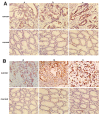Clinicopathological significance of NMIIA overexpression in human gastric cancer
- PMID: 23203126
- PMCID: PMC3509642
- DOI: 10.3390/ijms131115291
Clinicopathological significance of NMIIA overexpression in human gastric cancer
Abstract
Altered expressions of nonmuscle myosin IIA (NMIIA) have been observed in certain types of cancers, but the impact of the alterations in gastric cancer (GC) remains unclear. The purpose of this study was to evaluate the expression of NMIIA at the mRNA and protein level in patients with GC and to assess its clinical significance. We investigated the expression of NMIIA in fresh, paired GC tissues by reverse transcriptase polymerase chain reaction (RT-PCR; n = 14) and Western blot analysis (n = 36). Simultaneously, we performed immunohistochemistry (IHC) on paraffin embedded specimens, including 96 GC specimens, 30 matched normal specimens and 30 paired metastatic lymph node samples. NMIIA is overexpressed in GC compared with the adjacent normal gastric epithelium (p < 0.001) and high-level NMIIA expression is significantly correlated with the depth of wall invasion, lymph node metastasis, distant metastasis and Tumor Node Metastasis (TNM) stage. Furthermore, elevated NMIIA expression is an independent prognostic factor in multivariate analysis using the Cox regression model (p = 0.021). These findings indicate that overexpression of NMIIA may contribute to the progression and poor prognosis of GC.
Figures






References
-
- Jemal A., Bray F., Center M.M., Ferlay J., Ward E., Forman D. Global cancer statistics. CA: Cancer J. Clin. 2011;61:69–90. - PubMed
-
- Sereno M., Aguayo C., Guillén Ponce C., Gómez-Raposo C., Zambrana F., Gómez-López M., Casado E. Gastric tumours in hereditary cancer syndromes: Clinical features, molecular biology and strategies for prevention. Clin. Transl. Oncol. 2011;13:599–610. - PubMed
-
- Tahara E. Molecular mechanism of stomach carcinogenesis. J. Cancer Res. Clin. Oncol. 1993;119:265–272. - PubMed
-
- Barreto-Zuñiga R., Maruyama M., Kato Y., Aizu K., Ohta H., Takekoshi T., Bernal S.F. Significance of Helicobacter pylori infection as a risk factor in gastric cancer: Serological and histological studies. J. Gastroenterol. 1997;32:289–294. - PubMed
-
- Kim K.M., Kwon M.S., Hong S.J., Min K.O., Seo E.J., Lee K.Y., Choi S.W., Rhyu M.G. Genetic classification of intestinal-type and diffuse-type gastric cancers based on chromosomal loss and microsatellite instability. Virchows Arch. 2003;443:491–500. - PubMed
Publication types
MeSH terms
Substances
LinkOut - more resources
Full Text Sources
Other Literature Sources
Medical
Miscellaneous

